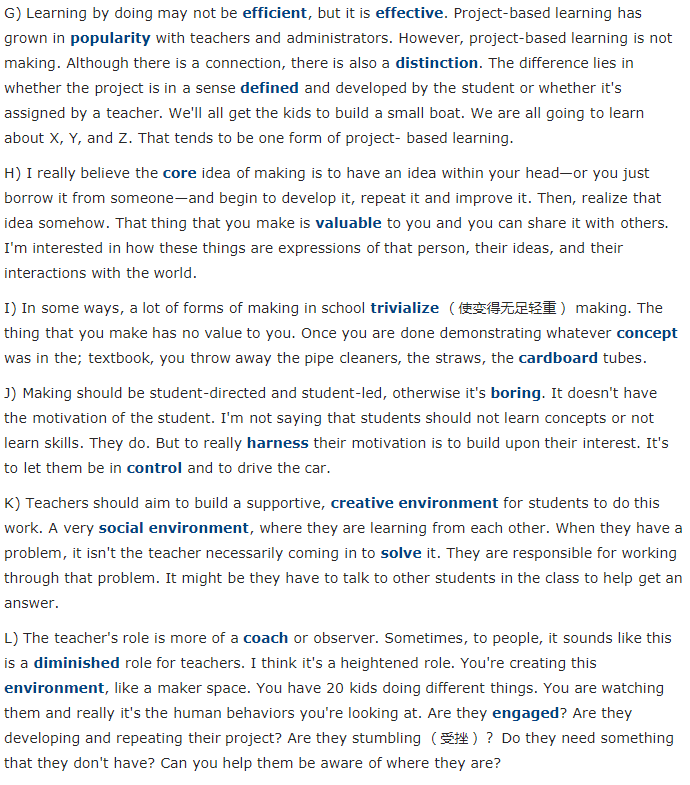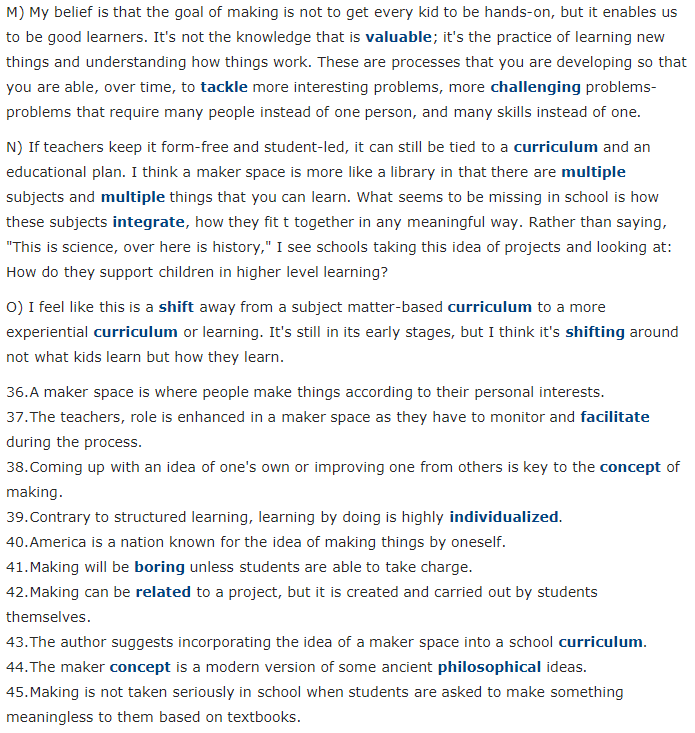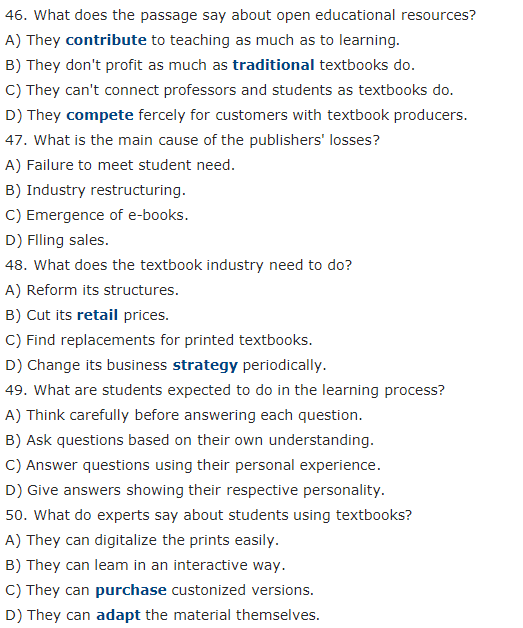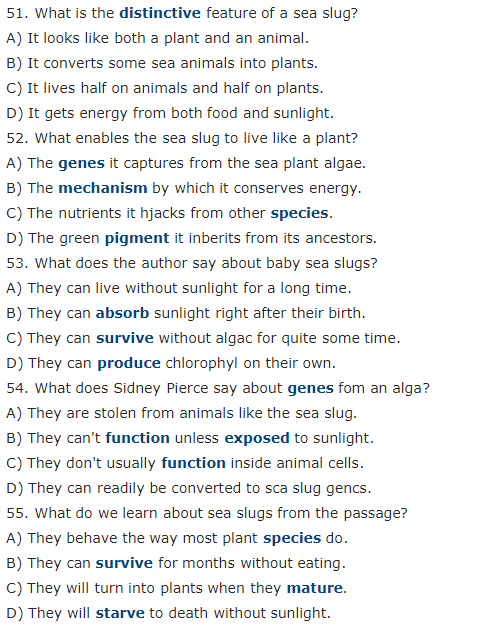A) We've always been a hands-on, do it-yourself kind of nation. Ben Franklin, one of America's founding fathers, didn't just invent the lightning rod. His creations include glasses, innovative stoves and more.
B) Franklin, who was largely self-taught, may have been a genius, but he wasn't really an exception when it comes to American making and creativity.
C) The personal computing revolution and philosophy of disruptive innovation of Silicon Valley grew, in part, out of the creations of the Homebrew Computer Club, which was founded in a garage in Menlo Park, California, in the mid-1970s. Members-including guys named Jobs and Wozniak-started making and inventing things they couldn't buy.
D) So it's no surprise that the Maker Movement today is thriving in communities and some schools across America. Making is available to ordinary people who aren't tied to big companies, big defense labs or research universities. The maker philosophy echoes old ideas advocated by John Dewey, Montessori, and even ancient Greek philosophers, as we pointed out recently.
E) These maker spaces are often outside of classrooms, and are serving an important educational function. The Maker Movement is rediscovering learning by doing, which is Dewey's phrase from 100 years ago. We are rediscovering Dewey and Montessori and a lot of the practices that they pioneered that have been forgotten or at least put aside. A maker space is a place which can be in a school, but it doesn't look like a classroom. It can be in a library. It can be out in the community. It has tools and materials. It's a place where you get to make things based on your interest and on what you, re learning to do.
F) Ideas about learning by doing have struggled to become mainstream educationally, despite being old concepts from Dewey and Montessori, Plato and Aristotle, and in the American context, Ralph Emerson, on the value of experience and self-reliance. It's not necessarily an efficient way to learn. We learn, in a sense, by trial and error. Learning from experience is something that takes time and patience. It's very individualized. If your goal is to have standardized approaches to learning, where everybody learns the same thing at the same time in the same way, then learning by doing doesn't really fit that mold anymore. It's not the world of textbooks. It's not the world of testing.


36-45:EICGK FBJDH
36.创客空间是人们根据个人兴趣制造东西的地方。
37.教师在创客空间中的角色得到加强,因为他们必须在这个过程中进行监督和促进。
38.想出一个自己的想法或者从别人那里改进一个想法是制造概念的关键。
39.与结构化学习相反,边做边学是高度个性化的。
40.美国是一个以自己制造东西而闻名的国家。
41.除非学生们能掌控一切,否则制作将是乏味的。
42.制作可以与一个项目相关,但它是由学生自己创建和执行的。
43.作者建议将创客空间的理念纳入学校课程。
44.创客概念是一些古代哲学思想的现代版本。
45.在学校里,当学生被要求根据教科书做一些对他们来说毫无意义的东西时,制作并没有受到重视。
Textbooks represent an 11 billion dollar industry, up from $8 billion in 2014. Textbook publisher Pearson is the largest publisher -- of any kind -- in the world.
It costs about $1 million to create a new textbook. A freshman textbook will have dozens of contributors, from subject-matter experts through graphic and layout artists to expert reviewers and classroom testers. Textbook publishers connect professors, instructors and students in ways that alternatives, such as open e-textbooks and open educational resources, simply do not. This connection happens not only by means of collaborative development, review and testing, but also at conferences where faculty regularly decide on their textbooks and curricula for the coming year.
It is true that textbook publishers have recently reported losses, largely due to students renting or buying used print textbooks. But this can be chalked up to the excessively high cost of their books -- which has increased over 1,000 percent since 1977. A restructuring of the textbook industry may well be in order. But this does not mean the end of the textbook itself.
While they may not be as dynamic as an iPad, textbooks are not passive or lifeless. For example, over the centuries, they have simulated (模拟) dialogues in a number of ways. From 1800 to the present day, textbooks have done this by posing questions for students to answer inductively (归纳性地). That means students are asked to use their individual experience to come up with answers to general questions. Today's psychology texts, for example, ask: "How much of your personality do you think you inherited?" while ones in physics say: "How can you predict where the ball you tossed will land?"
Experts observe that "textbooks come in layers, something like an onion." For an active learner, engaging with a textbook can be an interactive experience. Readers proceed at their own pace. They "customize" their books by engaging with different layers and linkages. Highlighting, Post-It notes, dog-ears and other techniques allow for further customization that students value in print books over digital forms of books.

When we think of animals and plants, we have a pretty good way of dividing them into two distinct groups: one converts sunlight into energy and the other has to eat food to make its energy. Well, those dividing lines come crashing down with the discovery of a sea slug (海蛞蝓) that's truly half animal and half plant. It's pretty incredible how it has managed to hijack the genes of the algae (藻类) on which it feeds.
The slugs can manufacture chlorophyll, the green pigment (色素) in plants that captures energy from sunlight, and hold these genes within their body. The term kleptoplasty is used to describe the practice of using hijacked genes to create nutrients from sunlight. And so far, this green sea slug is the only known animal that can be truly considered solar-powered, although some animals do exhibit some plant-like behaviors. Many scientists have studied the green sea slugs to confirm that they are actually able to create energy from sunlight.
In fact, the slugs use the genetic material so well that they pass it on to their future generations. Their babies retain the ability to produce their own chlorophyll, though they can't generate energy from sunlight until they've eaten enough algae to steal the necessary genes, which they can't yet produce on their own.
"There's no way on earth that genes from an alga should work inside an animal cell," says Sidney Pierce from the University of South Florida. "And yet here, they do. They allow the animal to rely on sunshine for its nutrition. So if something happens to their food source, they have a way of not starving to death until they find more algae to eat."
The sea slugs are so good at gathering energy from the sun that they can live up to nine months without having to eat any food. They get all their nutritional needs met by the genes that they've hijacked from the algae.

For this part, you are allowed 30 minutes to write a letter to a foreign friend who wants to teach English in China. Please recommend a city to him. You should write at least 120 words but no more than 180 words.
Directions: For this part, you are allowed 30 minutes to write a letter to a foreign friend who wants to study in China. Please recommend a university to him. You should write at least 120 words but no more than 180 words.
Directions: For this part, you are allowed 30 minutes to write a letter to a foreign friend who wants to teach English. Please recommend a city to him. You should write at least 120 words but no more than 180 words.
中国,地球上最吸引人的国家之一,有5000多年的历史,是目前全球第二大经济体(the second largest economy)。随着广泛的经济改革,中国正经历着显著、快速的变化。1949年以前的中国极端贫困、收入不平衡(incomeinequalities)、国家不安全。由于经济改革,从1980年开始,人民的生活水平开始提升至基本水平之上。全国人口有了足够的食物、衣服和住房,普通家庭可以吃得起各种各样的食物,穿得上时尚的衣服。
The fifth largest city in US passed a significant soda tax proposal that will levy (征税)1.5 cents per liquid ounce on distributors.
Philadelphil's new measure was approved by a 13 to 4 city council vote. It sets a new bar for similar initiatives across the country. It is proof that taxes on sugary drinks can win substantial support outside super-liberal areas. Until now, the only city to successfully pass and implement a soda tax was Berkeley, California, in 2014.
The tax will apply to regular and diet sodas, as well as other drinks with adder sugar, such as Gatorade and iced teas. It's expected to raise $410 million over the next five years, most of which will go toward funding a universal pre-kindergarten program for the city.
While the city council vote was met with applause inside the council room, opponents to the measure, including soda lobbyists, made sharp criticisms and a promise to challenge the tax in court.
"The tax passed today unfairly singles out beverages — including low —and no-calorie choices," said Lauren Kane, spokeswoman for the American Beverage Association. "But most importantly, it is against the law. So we will side with the majority of the people of Philadelphia who oppose this tax and take legal action to stop it."
An industry-backed anti-tax campaign has spent at least $4 million on advertisements. The ads criticized the measure, characterizing it as a "grocery tax".
Public health groups applauded the approved tax as step toward fixing certain lasting health issues that plague Americans. "The move to recapture a small part of the profits from an industry that pushed a product that contributes to diabetes, obesity and heart disease in poorer communities in order to reinvest in those communities will sure be inspirational to many other places," said Jim Krieger, executive director of Healthy Food America. "indeed, we are already hearing from some of them. It's not 'just Berkeley' anymore."
Similar measures in California's Albany, Oakland, San Francisco and Colorado's Boulder are becoming hot-button issues. Health advocacy groups have hinted that even more might be coming.
46. What does the passage say about the newly-approved soda tax in Philadelphia?
A) It will change the lifestyle of many consumers.
B) It may encourage other US cities to fllow suit.
C) It will cut soda consumption among low-income communities.
D) It may influence the marketing strategies of the soda business.
47. What will the opponents probably do to respond to the soda tax proposal?
A) Bargain with the city council.
B) Refuse to pay additional tax.
C) Take legal action against it.
D) Try to win public support.
48. What did the industry-backed anti-tax campaign do about the soda tax proposal?
A) It tried to arouse hostile felings among consumers.
B) It tried to win grocers' support against the measure.
C) It kept sending ltters of protest to the media.
D) It criticized the measure through advertising.
49. What did public health groups think the soda tax would do?
A) Alert people to the risk of sugar-induced diseases.
B) Help people to fix certain long-time health issues.
C) Add to the fund for their rescarch on discases.
D) Benefit low-income people across the country.
50. What do we lear about similar measures concening the soda tax in some other citics?
A) They are becoming rather sensitive issues.
B) They are spreading panic in the soda industry.
C) They are reducing the incidence of sugar-induced diseases.
D) They are taking away a lot of proft from the soda industry.
鱼是春节前夕餐桌上不可或缺的一道菜,因为汉语中“鱼”字的发音与“余”字的发音相同。正由于这个象征性的意义,春节期间鱼也作为礼物送给亲戚朋友。鱼的象征意义据说源于中国传统文化。中国人有节省的传统,他们认为节省得愈多,就感到愈为安全。今天,尽管人们愈来愈富裕了,但他们仍然认为节省是一种值得弘扬的美德。
生活在中国不同地区的人们饮食多种多样。北方人主要吃面食,南方人大多吃米饭。在沿海地区,海鲜和淡水水产品在人们饮食中占有相当大的比例,而在其他地区人们的饮食中,肉类和奶制品更为常见。四川、湖南等省份的居民普遍爱吃辛辣食物,而江苏和浙江人更喜欢甜食。然而,因为烹饪方式各异,同类食物的味道可能会有所不同。
A) Getting around a city is one thing -- and then there's the matter of getting from one city to another. One vision of the perfect city of the future: a place that offers easy access to air travel.In 2011, a University of North Carolina business professor named John Kasarda published a book called Aerotropolis: The Way We'll Live Next. Kasarda says future cities should be built intentionally around or near airports. The idea, as he has put it, is to offer businesses "rapid, long-distance connectivity on a massive scale."
B) "The 18th century really was a waterborne century, the 19th century a rail century, the 20th century a highway, car, truck century -- and the 21st century will increasingly be an aviation century, as the globe becomes increasingly connected by air," Kasarda says.Songdo, a city built from scratch in South Korea, is one of Kasarda's prime examples. It has existed for just a few years."From the get-go, it was designed on the basis of connectivity and competitiveness," says Kasada. "The government built the bridge directly from the airport to the Songdo International Business District. And the surface infrastructure was built in tandem with the new airport."
C) Songdo is a stone's throw from South Korea's Incheon Airport, its main international hub. But it takes a lot more than a nearby airport to be a city of the future. Just building a place as an "international business district" doesn't mean it will become one. Park Yeon Soo conceived this city of the future back in 1986. He considers Songdo his baby. "I am a visionary," he says.Thirty years after he imagined the city, Park's baby is close to 70 percent built, with 36,000 people living in the business district and 90,000 residents in greater Songdo. It's about an hour outside Seoul, built on reclaimed tidal flats along the Yellow Sea. There's a Coast Guard building and a tall trade tower, as well as a park, golf course and university.
D) Chances are you've actually seen this place. Songdo appears in the most famous music video ever to come out of South Korea."Gangnam Style" refers to the fashionable Gangnam district in Seoul. But some of the video was filmed in Songdo."I don't know if you remember, there was a scene in a subway station. That was not Gangnam. That was actually Songdo," says Jung Won Son, a professor of urban development at London's Bartlett School of Planning. "Part of the reason to shoot there is that it's new and nice."
E) The city was supposed to be a hub for global companies, with employees from all over the world. But that's not how it has turned out.Songdo's reputation is as a futuristic ghost town. But the reality is more complicated.A bridge with big, light-blue loops leads into the business district. In the center of the main road, there's a long line of flags of the world. On the corner, there's a Starbucks and a 7-Eleven -- all of the international brands that you see all over the world nowadays.
F) The city is not empty. There are mothers pushing strollers, old women with walkers -- even in the middle of the day, when it's 90 degrees out. Byun Young-Jin chairs the Songdo real estate association and started selling property here when the first phase of the city opened in 2005. He says demand has boomed in the past couple of years.Most of his clients are Korean. In fact, the developer says, 99 percent of the homes here are sold to Koreans. Young families move here because the schools are great.And that's the problem: Songdo has become a popular Korean city -- more popular as a residential area than a business one. It's not yet the futuristic international business hub that planners imagined. "It's a great place to live. And it's becoming a great place to work," says Scott Summers, the vice president of Gale International, the developer of the city. The floor-to-ceiling windows of his company's offices overlook Songdo Central Park, with a canal full of kayaks and paddle boats. Shimmering glass towers line the canal’s edge.
G) "What's happened is, because we focused on creating that quality of life first, which enabled the residents to live here, what has probably missed the mark is for companies to locate here," he says. "There needs to be strong economic incentives."The city is still unfinished, and it feels a bit like a theme park. It doesn't feel all that futuristic. There's a high-tech underground trash disposal system. Buildings are environmentally friendly. Everybody's television set is connected to a system that streams personalized language or exercise classes.
H) But Star Trek this is not. And to some of the residents, Songdo feels hollow."I'm, like, in prison for weekdays. That's what we call it in the workplace," says a woman in her 20s. She doesn't want to use her name for fear of being fired from her job. She goes back to Seoul every weekend. "I say I'm prison-breaking on Friday nights."But she has to make the prison break in her own car. There's no high-speed train connecting Songdo to Seoul, just over 20 miles away.
I) The man who first imagined Songdo feels frustrated, too. Park says he built South Korea a luxury vehicle, "like Mercedes or BMW. It's a good car now. But we're waiting for a good driver to accelerate."But there are lots of other good cars out there, too. The world is dotted with futuristic, high-tech cities trying to attract the biggest international companies.
J) Songdo's backers contend that it's still early, and business space is filling up -- about 70 percent of finished offices are now occupied.Brent Ryan, who teaches urban design at MIT, says Songdo proves a universal principle. "There have been a lot of utopian cities in history. And the reason we don't know about a lot of them is that a lot of them have vanished entirely."In other words, when it comes to cities -- or anything else -- it is hard to predict the future.
36. Songdo's popularity lies more in its quality of life than its business attraction.
37. The man who conceived Songdo feels disappointed because it has fallen short of his expectations.
38. A scene in a popular South Korean music video was shot in Songdo.
39. Songdo still lacks the financial stimulus for businesses to set up shop there.
40. Airplanes will increasingly become the chief means of transportation, according to a professor.
41. Songdo has ended up diferent from the city it was supposed to be.
42. Some of the people who work in Songdo complain about boredom in the workplace.
43. A business professor says that a future city should have easy access to international transportation.
44. According to an urban design professor, it is difficult for city designers to foresce what will happen in the future.
45. Park Yeon Soo, who envisioned Songdo, feels a parental connction with the city.